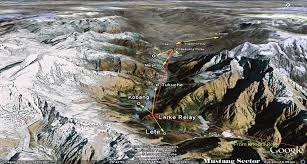Big in all possible dimensions, the Annapurna Circuit is nothing short of a gargantuan adventure deep into the mountains and away from everything that reminds you of what noise modern society makes. And yet even here in the hinterland, it’s not hard to understand the impulse to stay connected — to post photos of impossibly beautiful scenery on social media, check in with family, or download tomorrow’s trail map. Optical fibre and Wi-Fi – the legend of digital connectivity being a myth in these parts has long gon, thanks to improved infrastructure, but that brave new world is still fluctuating, changing all the time, a nd definitely somewhat expensive. Mastering this divide in the digital era requires being prepared, knowledge of two primary ways to connect, and smart battery management. This comprehensive guide will help you sort through the complexities of finding Wi-Fi and a network through Nepal’s breathtaking Annapurna region.
The two sides of connectivity: Teahouse Wi-Fi vs. local SIM cards
Teahouse Wi-Fi and Data Trekkers on the Annapurna Circuit have two ways to connect to the internet: teahouse or lodge Wi-Fi, and mobile data through a local SIM card. Each one is a silver bullet, and many trekkers report that they benefit from both in combination to increase their chances of getting online. There is essentially a kind of WiFi in teahouses along the way as well, especially in lower to mid-level altitude locations. A SIM from a local carrier, meanwhile, offers a less dependent connection based on the network of mobile towers.
The Tussle of NTC and Ncell for Mobile Networks
If you wanted to use data on your phone, you would need to purchase a local prepaid SIM. Nepal’s two big mobile phone carriers are Nepal Telecom (NTC) and Ncell. For trekking in the Annapurna area, it’s worth noting that NTC has better coverage on the relatively remote and high altitude parts of the trail where you might want a signal. Ncell works excellently in Kathmandu and Pokhara, but you start to lose it as you ascend deeper into the mountains. If you want to go full addicted to social media and whatnot, I really recommend buying a SIM card (with a lot of data) in Kathmandu or Pokhara before starting the trek. Then there are competitive tourist-friendly packages from both providers.
Geographical Breakdown of Internet Availability
The Annapurna Circuit Trek depends on the Internet access, only on the height, and on how big the village is. Connectivity is generally decent and consistent in the lower half of this trek as well, available easily enough at both teahouse Wi-Fi and mobile data until villages like Chame. The further you go beyond Chame toward the Manang Valley, the spottier the coverage. Manang itself is a crucial acclimatization stop but also a good place to update your social media, as the internet was (while more expensive than in the lower villages) far better in many of these lodges, with some even offering working Wi-Fi. The entire section from Manang through and over the Thorong La Pass and beyond, with high camps, is a “connectivity void.” Cell phone signal is patchy to nonexistent, and teahouse Wi-Fi (if available) still tends to be out of order, inconsistent, or prohibitively expensive until you’re off the trail in Muktinath and Jomsom at the other side of the pass.
The High and Growing Cost of Being Connected
Currency is digital on the Annapurna Circuit, and value increases with elevation. In the lower valleys, there are a few teahouses where you can get free Wi-Fi for guests or pay a few pennies. But at 2,500 meters, everything shifts. A Wi-Fi password typically costs $2-5 per time frame (ie, for the night). The cost reflects the difficulty and cost of running internet connections to remote lodges, where satellite-based internet is fueled by solar or mini-hydro plants. And I want to emphasize that charge is not paying for speed or quality; it’s just access.
Power Management in an Industrial Power-Constrained Environment
Power on the trail is usually generated via local solar panels or small hydro systems, depending on weather conditions, and with very little at high-altitude settlements. To conserve the battery and continue conserving money, employ power management that is extremely tight. Available in a whole range of different exteriors, reasonable capacity (unless otherwise stated) as power banks go, which you’ll probably use all the time while on trek – far cheaper than forking out every day to charge your phone in a teahouse at higher altitudes.Very possibly your most important piece of electronic gear..! If you are not going to use it as a nav or getting on a call, then keep it in airplane mode if only for battery reasons (it kills the battery trying to hunt for that 1 bar of signal…or zero). Also, setting your screen brightness to dim (depending on lighting conditions) and closing apps running in the background does exceptionally well for battery life.
Preparation: Downloading Offline Tools
That the connection is spotty even at its best, and nonexistent at worst, suggests that relying on internet connectivity as a surefire navigation tool is an urbanist recipe for tension (and getting lost). Smart prep is a matter of offline resources. Most importantly, however, is that you download a reliable trekking map for the entire Annapurna Circuit, as well as any sidetrips to whichever of your favourite hard-core offline maps will allow it (Maps). Mee or Gaia GPS, before you leave Kathmandu or Pokhara. Stock up on whatever diversions (entertainment, books, music, or podcasts) you want for the quiet evenings in; teahouse Wi-Fi is rarely strong enough to stream.
Digital Detox: Embracing the Disconnect
You will need to arrange Wi-Fi, of course, but many of those who take on the Annapurna Circuit view it as a welcome break from the excessive connectivity elsewhere. The hot-and-heavy nature of all things Wi-Fi is, of course, a good sign that it wants you to PUT YOUR DEVICE AWAY and BE IN THE MOMENT with your ACTUAL SURROUNDINGS. Evenings in the teahouses were best enjoyed reading, writing in a journal, chatting with your guide, or exchanging stories with other trekkers from every country under the sun. You can really take in the stunning mountain scenery, immerse yourself in the local culture, and of course live the experience itself without being continually pestered by those damned notifications and regular badgering by the internet demanding your constant attention.
Final Thoughts on Connectivity
Annapurna Circuit Trekking is about connectivity that can only be described as awesome, and the remoteness of the land. In most cases, you can be in touch with the outside world, yet your expectations should not exceed a slow or sometimes non-existent connection (and one that is often at a high altitude while climbing). Uniform digital blackouts, you would have figured, thanks to local NTC SIM cards, monster power banks, and downloaded maps and entertainment. (“Cool it, Emarce. It’s so peaceful on this side of the pass. And attend to your sporadic Wi-Fi check-ins only when actually needed… because let’s face it, real connections are found out there on those Annapurna Circuit trails; not behind a screen but in front of these epic Himalayan ranges and captivating culture.”)


